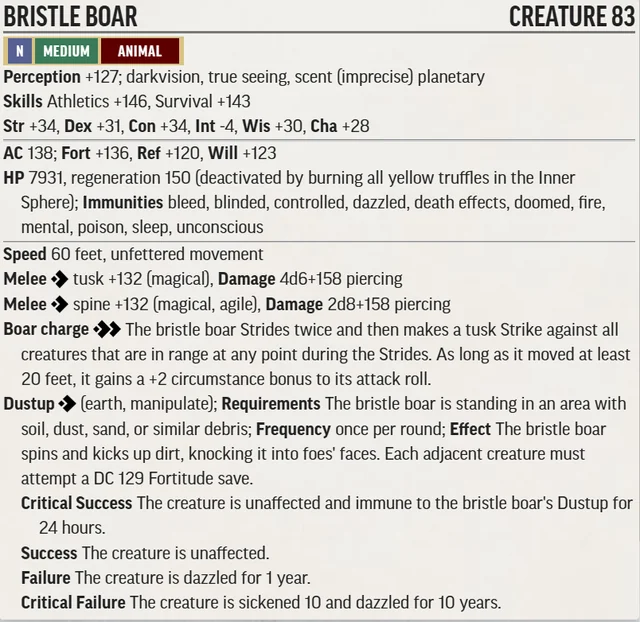Well, I was going to have the party meet an owlbear, but a bugbear it is, now.
Data scientist, video game analyst, astronomer, and Pathfinder 2e player/GM from Halifax, Nova Scotia.
- 4 Posts
- 9 Comments

 1·4 days ago
1·4 days agoIt’s not so bad! It’s just a DC 129 Fort save!

 5·4 days ago
5·4 days agoAnd, of course, because the Internet is full of nerds, someone has fixed the stat block to be on spec with its level:


 2·5 days ago
2·5 days ago@dmmacniel@feddit.org The point is, the system readily supports more casual – more chill – play, which is something that the subreddit in particular often openly argues against. And that chill play can highlight a lot of strengths of the system that the core player base seems to totally ignore. Indeed, it rectifies a lot of issues that people keep bringing up about “useless” feats, spells, and items.
To quote myself:
What I’ve really found, too, is that having a game that is less tuned allows the players to play their characters. To choose feats, spells, and actions that are harmonious with those characters, and with their canon experiences had at the table. And, importantly, it’s made a lot of those “useless” feats, spells, and bits of gear useful. It provides them a real place in the game, because they’re being used to express the character, not just optimize their combat loop.
Moreover, it allows the system to breathe. The game provides a lot of systems, guidance, suggestions, and ways to resolve situations or actions. If you’re redlining the game all of the time, these things become the experience. The player becomes focused on figuring out what resolution mechanic they want to trigger, and the decision making process boils down to pushing the right buttons at the right time. There’s no room to express things in anything but the clearest, most mechanical language.
But the game doesn’t need to play that way. The Actions and resolution mechanics can be pushed entirely behind the screen, and treated as part of the game engine. Just as you don’t need to know about how, say, Doom 2 renders a map, about sectors, sector boundaries, sector effects, the 2D nature of the game, etc. to sit down and play it, you don’t need to be cognizant of Actions and Activities, the distinction between Stride and Step, etc. to play Pathfinder 2. But if you’re speed running on Nightmare difficulty, the technical elements of the engine become important.
The unfortunate thing is, most online discussion about the game is focused on the equivalent of Nightmare speed runs.
This is unfortunate specifically because the discussions in the largest online communities focused on the game make the game seem very rigid, rather than very flexible. It makes it seem like the game doesn’t support a beer-and-pretzels table, when, in fact, it supports that kind of play very well.
It just also supports other kinds of play very well, too.

 7·5 days ago
7·5 days agoIt’s not a typo, it’s an act of the gods! Or Gord, maybe.

 2·2 months ago
2·2 months ago@jjjalljs@ttrpg.network Sigil was a project to double-down on ecosystem lock-in and introduce microtransactions into the game at a time where online play was/is ballooning. And it probably had a lot of potential to achieve those things, if not for Hasbro’s seemingly constant refocusing and shifting short term goals.
It’s good for the hobby that it’s DOA, but being so dismissive of it because it’s not something you personally see value in just kind of sounds like burying your head in the sand to the very real changes the hobby has been undergoing since lockdowns started five years ago.
Sigil had the potential to not just lock players into the D&D Beyond ecosystem (even more so than Beyond already does), but also to be a poison pill against homebrew in general.
It would have been a Curse of Strahd machine. Something that has full support for official moduals and rulebooks, and functionally no support for anything else. And there was a very, very, very real chance that it would have worked.

 1·2 months ago
1·2 months agoMy mom makes these bierocks. I make just the filling (they’re good without the cheese, too, if anyone’s got insides that hate milk sugars or proteins).
There are less kiddie bierock recipes out there, too, if ketchup doesn’t appeal.
https://www.food.com/recipe/stuffed-hamburger-cabbage-buns-runzas-or-bierocks-50809
Hmm. Something seems a little out of wack, as XP doubles every 2 levels, but you’re scaling things linearly here. One Level 1 creature is worth 40 XP to a combat vs a group of 4 Level 1 PCs, so things work out here. But a Level 2 creature is worth 60 XP, not 80, and 60 * 4 = 240, not 320.
If you’re indexing the creature XP to Level 1, the XP curve looks like this (where Approx XP uses a 240 baseline for Level 2 as they do in the books, and XP is using exact scaling):
Level XP Approx XP Linear Scaling 1 160.0 160 160 2 226.3 240 320 3 320.0 320 480 4 452.5 480 640 5 640.0 640 800 6 905.1 960 960 7 1280.0 1280 1120 8 1810.2 1920 1280 9 2560.0 2560 1440 10 3620.4 3840 1600 11 5120.0 5120 1760 12 7240.8 7680 1920 13 10240.0 10240 2080 14 14481.5 15360 2240 15 20480.0 20480 2400 16 28963.1 30720 2560 17 40960.0 40960 2720 18 57926.2 61440 2880 19 81920.0 81920 3040 20 115852.4 122880 3200 21 163840.0 163840 3360 22 231704.8 245760 3520 23 327680.0 327680 3680 24 463409.5 491520 3840 25 655360.0 655360 4000 26 926819.0 983040 4160 27 1310720.0 1310720 4320 28 1853638.0 1966080 4480 29 2621440.0 2621440 4640 30 3707276.0 3932160 4800 Using Level 1 indexed XP (let’s call it XP_1, for the sake of brevity), your example above becomes 560 XP shared between either 4 equally levelled characters (140 XP) or 3 unequally levelled ones, with it being unclear how exactly to divvy up the reward.
I’m not convinced your use of level as weight works, due to the fact that level power does not scale linearly. Instead, I would look to the players’ contribution to the party’s XP pool. PCs have an encounter XP budget that’s the same as monsters’, by level, which means the mixed party has 160+240+240 = 640 XP between them. The Level 1 character contributes 160/640 = 0.25, or 1/4 of the party’s XP, so they should probably receive 1/4 of the XP reward.
560 * 0.25 = 140 XP, which is what they would get if it was a party of 4 Level 1 PCs.
The other two characters each contribute 37.5% of the party’s XP, so they would each receive 560 * 0.375 = 210 XP, which would scale to 150 XP in the standard rolling XP window.
I’ve been kicking this math around for a while now on scrap paper. There’s been a small spike in questions around XP and balance over on r/Pathfinder2e, though, so maybe I’ll work through his a little and make it a little more accessible/searchable.



Thankfully, no one at my table knows what a bugbear is. And that’s also just not the way English tends to work. A bearbug is clearly a small, hairy beetle.